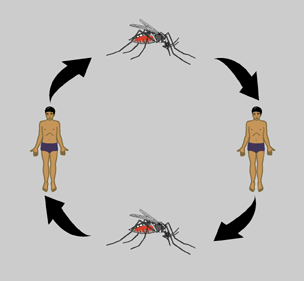Effects of Pathogen-Vector Interactions on the Transmission of Dengue Virus: Difference between revisions
| Line 1: | Line 1: | ||
<br> | <br> | ||
== | ==Life Cycle== | ||
<br> | |||
[[File: Skeeter-human-skeeter-human.gif|400px|thumb|left|Figure 4. Transmission cycle of dengue virus between human hosts and mosquito vectors.[10]]] | |||
<br> | |||
Regardless of the host, the dengue virus life cycle begins with infection of a human or nonhuman primate host via the bite of an infected mosquito vector. Hosts begin to experience symptoms four to seven days post infection with symptoms usually lasting three to ten days after which there is about a three week recovery period [8]. The virus initially replicates in target organs like the liver, spleen, and thymus but eventually makes its way to the lymphatic system where it replicates in lymph tissue and white blood cells. The lymphatic system serves as a gateway to the bloodstream where the virus continues to replicate. Eventually, there are high titers of virus in the blood (viremia) and disease transmission can occur. For a period of about five days, just before symptoms appear the virus is transmissible to a new mosquito vector through and infected blood meal. | |||
<br><br> | <br><br> | ||
Transmission of dengue virus arises when an uninfected mosquito bites an infected host and takes up virus with its blood meal. The virus replicates in the midgut of the mosquito then infects its hemocoel (body cavity). From the hemocoel the virus eventually makes its way to the salivary glands. Once the salivary glands are infected the mosquito can infect other human hosts and the cycle continues [4]. The length of time required for virus to reach the salivary glands of a mosquito after the ingestion of an infected blood meal is about eight to ten days depending on both viral and host factors [8]. | |||
Revision as of 17:58, 7 December 2010
Life Cycle
Regardless of the host, the dengue virus life cycle begins with infection of a human or nonhuman primate host via the bite of an infected mosquito vector. Hosts begin to experience symptoms four to seven days post infection with symptoms usually lasting three to ten days after which there is about a three week recovery period [8]. The virus initially replicates in target organs like the liver, spleen, and thymus but eventually makes its way to the lymphatic system where it replicates in lymph tissue and white blood cells. The lymphatic system serves as a gateway to the bloodstream where the virus continues to replicate. Eventually, there are high titers of virus in the blood (viremia) and disease transmission can occur. For a period of about five days, just before symptoms appear the virus is transmissible to a new mosquito vector through and infected blood meal.
Transmission of dengue virus arises when an uninfected mosquito bites an infected host and takes up virus with its blood meal. The virus replicates in the midgut of the mosquito then infects its hemocoel (body cavity). From the hemocoel the virus eventually makes its way to the salivary glands. Once the salivary glands are infected the mosquito can infect other human hosts and the cycle continues [4]. The length of time required for virus to reach the salivary glands of a mosquito after the ingestion of an infected blood meal is about eight to ten days depending on both viral and host factors [8].

